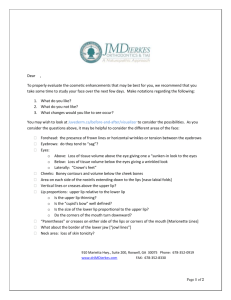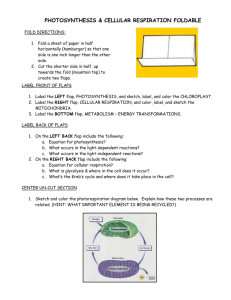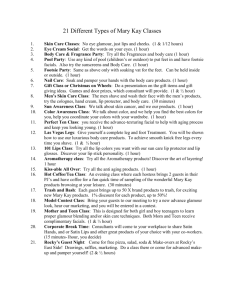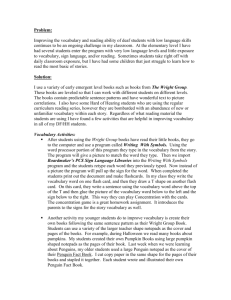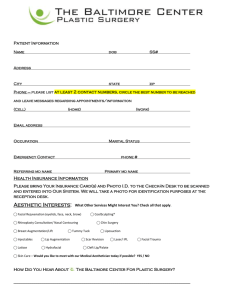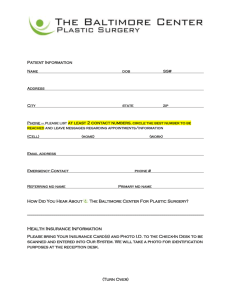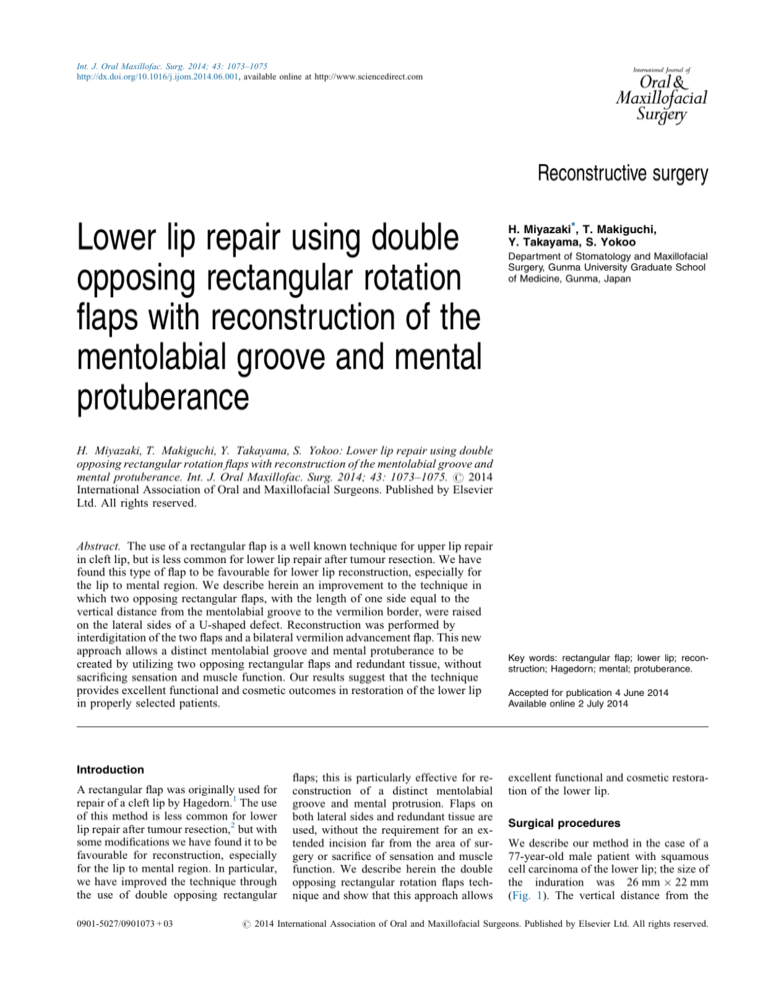
Int. J. Oral Maxillofac. Surg. 2014; 43: 1073–1075
http://dx.doi.org/10.1016/j.ijom.2014.06.001, available online at http://www.sciencedirect.com
Reconstructive surgery
Lower lip repair using double
opposing rectangular rotation
flaps with reconstruction of the
mentolabial groove and mental
protuberance
H. Miyazaki*, T. Makiguchi,
Y. Takayama, S. Yokoo
Department of Stomatology and Maxillofacial
Surgery, Gunma University Graduate School
of Medicine, Gunma, Japan
H. Miyazaki, T. Makiguchi, Y. Takayama, S. Yokoo: Lower lip repair using double
opposing rectangular rotation flaps with reconstruction of the mentolabial groove and
mental protuberance. Int. J. Oral Maxillofac. Surg. 2014; 43: 1073–1075. # 2014
International Association of Oral and Maxillofacial Surgeons. Published by Elsevier
Ltd. All rights reserved.
Abstract. The use of a rectangular flap is a well known technique for upper lip repair
in cleft lip, but is less common for lower lip repair after tumour resection. We have
found this type of flap to be favourable for lower lip reconstruction, especially for
the lip to mental region. We describe herein an improvement to the technique in
which two opposing rectangular flaps, with the length of one side equal to the
vertical distance from the mentolabial groove to the vermilion border, were raised
on the lateral sides of a U-shaped defect. Reconstruction was performed by
interdigitation of the two flaps and a bilateral vermilion advancement flap. This new
approach allows a distinct mentolabial groove and mental protuberance to be
created by utilizing two opposing rectangular flaps and redundant tissue, without
sacrificing sensation and muscle function. Our results suggest that the technique
provides excellent functional and cosmetic outcomes in restoration of the lower lip
in properly selected patients.
Introduction
A rectangular flap was originally used for
repair of a cleft lip by Hagedorn.1 The use
of this method is less common for lower
lip repair after tumour resection,2 but with
some modifications we have found it to be
favourable for reconstruction, especially
for the lip to mental region. In particular,
we have improved the technique through
the use of double opposing rectangular
0901-5027/0901073 + 03
flaps; this is particularly effective for reconstruction of a distinct mentolabial
groove and mental protrusion. Flaps on
both lateral sides and redundant tissue are
used, without the requirement for an extended incision far from the area of surgery or sacrifice of sensation and muscle
function. We describe herein the double
opposing rectangular rotation flaps technique and show that this approach allows
Key words: rectangular flap; lower lip; reconstruction; Hagedorn; mental; protuberance.
Accepted for publication 4 June 2014
Available online 2 July 2014
excellent functional and cosmetic restoration of the lower lip.
Surgical procedures
We describe our method in the case of a
77-year-old male patient with squamous
cell carcinoma of the lower lip; the size of
the induration was 26 mm 22 mm
(Fig. 1). The vertical distance from the
# 2014 International Association of Oral and Maxillofacial Surgeons. Published by Elsevier Ltd. All rights reserved.
1074
Miyazaki et al.
Fig. 1. A 77-year-old man with squamous
cell carcinoma of the lower lip, occupying
the central portion of the lower lip. Incision
line for tumour resection and use of a double
opposing rectangular rotation flap.
Fig. 2. Diagram of the procedures. One side of the square flap is equal to the preoperative
distance from the vermilion border to the mentolabial groove.
mentolabial groove to the vermillion border and the transverse length of the vermilion curved line at the vermilion border
were measured preoperatively.
In this patient, the tumour was resected
with a safety margin and the transverse
length of the defect was estimated to
be 70% preoperatively. A superiorly and
laterally based rectangular flap A0 BCD
and the oblique through the incision
line X0 (Y)Z for creating the medial
angle to receive the square flap were outlined along the U-shaped margin, with
X0 (Y)Z = YW = A0 B = BC = CD (Figs. 1
and 2). The length was made equal to the
preoperative vertical distance from the
mentolabial groove to the vermilion border. Upward rotation of flap A0 BCD and
downward rotation of angle X0 ZY then
permitted interdigitation of each component. The location of rectangular flap
A0 BCD was placed close to the centre,
which makes it important to determine
points B and X0 .
The additional segment that was excised to tailor the closure inferiorly could
be determined in advance by striking
equal arcs from Y and D to find point
O. In the original report, the resulting
redundancy at the inferior angle was
corrected like a wedge resection.2 However, we trimmed the inferior angle to
make DO and YO refracted and curved
in an attempt to minimize discarded
tissue. Finally the two opposing flaps,
ZYWO and A0 BCD, were interdigitated
to give a protrusion of the mentum
using the abundant redundant tissue
(Figs. 2 and 3). For a vermilion defect,
a bilateral vermilion advancement flap3
with extended incision into the oral cavity
was used and provided sufficient volume
(Fig. 3).
Photographs just after the operation
and at 18 months postoperatively are
shown in Figs. 3 and 4, respectively.
The contour and symmetry of the lower
lip to the mentum showed a favourable
outcome. The suture line was placed in the
centre of the mentum, but the scar was
barely visible after 18 months (Fig. 4).
The contour line of the reconstructed
lower lip and the hollow just below and
the reconstructed mental protuberance are
particularly noteworthy. The functional
results were also good. Thus, satisfactory
results were obtained both aesthetically
and functionally.
Fig. 3. Just after the operation. The rectangular flap is interdigitated to the opposite side,
forming the protrusion of the mental protuberance. The bilateral vermilion advancement
flaps are united and provide sufficient volume.
Fig. 4. Eighteen months after the operation.
The scar is barely visible. A good contour of
the lower lip to the mentum is present, with
reconstruction of a distinct mentolabial
groove (arrowhead) and protrusion of the
mental protuberance.
Discussion
Andrews first reported the application of
Hagedorn’s rectangular flap method to
lower lip repair after cancer ablation.1,2
The use of this method has not become
common, but we have used the rectangular
flap principle for treatment of lower lip
defects of a third to two-thirds or more of
the lip, and especially for defects of the
central region. This is a very simple technique that does not require an extended
incision far from the area of surgery, such
as in the cheek or nasolabial area, or large
incisions that could injure sensory or motor nerves and muscle. Most importantly,
we have found that this method produces
good muscle function and good cosmetic
results, in particular for the mental area.
In lower lip reconstruction, it is important to form a normal contour of the
mentolabial groove and mental protuberance. Many techniques have been described, but none have provided entirely
satisfactory reconstruction of the mental
contour. Andrews did not discuss the appropriate size of the flap,2 but we found
that a square flap with a length equal to the
preoperative vertical distance from the
mentolabial groove to the vermilion border was appropriate for reproduction of
the preoperative length. Strain on the tissue caused by opening the incision line
X0 (Y)Z and interdigitation of the square
flap helps make the mentolabial groove,
the hollow just above the groove, and
the mental protrusion distinct. The suture
lines in transverse directions were adjusted to the newly reconstructed vermilion
border and mentolabial groove to make
them inconspicuous.
The interdigitation of the rectangular
flaps should be placed as close to the
centre as possible to ensure that the suture
line below the mentolabial groove is also
located at the centre of the mentum. This is
a risk, but it provides redundant tissue in
Lower lip repair
this area (Figs. 2–4). Recently, we
reported a combined bilateral hatchet
and nasolabial advancement flaps technique.4 That technique and the technique
presented herein are different procedures,
but the principle of reconstruction is basically the same, i.e., prominence and depression of the ‘dog ear’ and redundant
tissue resulting from suturing two flaps
medially contribute to making a natural
contour of the mentum.4 In particular, we
would rather produce a distinct protrusion
of the mental protuberance using redundant tissue than discard this tissue, and we
consider this concept to be very important
in lower lip reconstruction.4 A suture line
located in the centre of the mentum is
favourable and a conspicuous scar can
be avoided by meticulous dermal suture
(Fig. 4).4 Also, since the suture line was
curved and refracted at an inferior angle,
rather than linear, a roundish, normally
shaped mental protuberance could be
formed (Figs. 3 and 4).
In reconstruction of the vermilion,
Andrews used mucosa to cover the free
border by traction of the edge of the
mucosa in the oral cavity.2 However, this
tends to cause a thin reconstructed vermilion. Therefore, we often use a vermilion
advancement flap3 or commissure-based
buccal mucosal flap.5 Both flaps include
muscle, and are stable and well vascularized. Proper unity of the muscle can provide sufficient volume and muscle
function.3,5
The method described here may be best
indicated for cases with a defect mainly in
the central region of the lower lip. There
are many such cases, since the incidence
of lower lip cancer is higher in the central
region.6 An indication for cases in which
the defect location deviates laterally is
also possible. Bretteville-Jensen stated
that the original method described by
Andrews could be applied to defects of
between a third and two-thirds of the
transverse lip length.7 Our modified method can be applied to even longer defects by
closing point X0 to point B to an appropriate length. For cases with a defect involving the whole of the lower lip, or those
involving oral commissures, we often use
another local flap, such as a gate flap or fan
flap, or the free flap technique.8
In conclusion, we suggest that the double opposing rectangular rotation flaps
technique provides less invasive treatment
and excellent functional and cosmetic outcomes in restoration of the lower lip in
properly selected patients.
Funding
None.
Competing interests
None declared.
Ethical approval
Not required.
Patient consent
Obtained.
Appendix A. Supplementary data
Supplementary data associated with
this article can be found, in the online
version, at http://dx.doi.org/10.1016/j.
ijom.2014.06.001.
1075
References
1. Hagedorn W. Uber ein Modifikation der
Hasencharten Operation. Zentabl Chir
1884;2:756–8.
2. Andrews EB. Repair of lower lip defects by
the Hagedorn rectangular flap method. Plast
Reconstr Surg 1964;34:27–33.
3. Goldstein MH. A tissue-expanding vermilion
myocutaneous flap for lip repair. Plast
Reconstr Surg 1984;73:768–70.
4. Makiguchi T, Yokoo S, Miyazaki H, Soda T,
Terashi H. Combined bilateral hatchet and
nasolabial advancement flaps for a large defect of the lower lip. J Craniofac Surg
2013;24:e588–90.
5. Tezel E, Numanoğlu A, Celebiler O, Bayramiçli M. Commissure-based buccal mucosal
flap. Plast Reconstr Surg 1998;101:1223–7.
6. Bilkay U, Kerem H, Ozek C, Gundogan H,
Guner U, Gurler T, et al. Management of
lower lip cancer: a retrospective analysis of
118 patients and review of the literature. Ann
Plast Surg 2003;50:43–50.
7. Bretteville-Jensen G. Reconstruction of the
lower lip after central excisions. Br J Plast
Surg 1973;26:247–51.
8. Neligan PC. Cheek and lip reconstruction. In:
Neligan PC, editor. Plastic surgery. 3rd ed.
New York: Elsevier Saunders; 2013. p. 254.
Address:
Department of Stomatology and Maxillofacial
Surgery
Gunma University Graduate School of
Medicine
3-39-22
Showa-machi
Maebashi
Gunma 371-8511
Japan
Tel: +81 27 220 8484; Fax: +81 27 220 8497
E-mail: miyaosur@gunma-u.ac.jp

